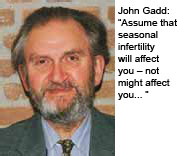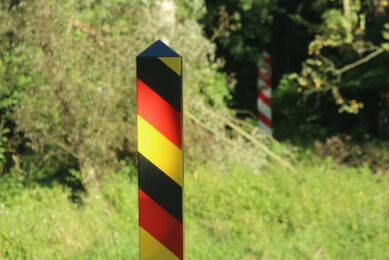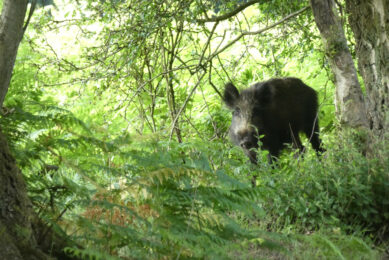What the textbooks don’t tell you about…Seasonal infertility – some recent thoughts

One of the problems of this seasonal disorder – or disorders as I described last month – is that they can often appear out of the blue especially in autumn and early winter. Judging by the number of callouts I get as the evenings shorten – in any latitude – they are mostly from producers who have not been particularly troubled in the past and have been caught out by several of the symptoms I described in the preceding issue.
So this piece is not really written for those who have had to battle against the problems which seasonal infertility has caused them, as they have learnt from experience how to anticipate things. The veterinarians have done much to advise those who have encountered the disorders year-on-year and the more wary breeders have benefited from both this guidance and their experience of what precautionarymeasures have been useful.
The critical knowledge gap
As I see it, the main difference between the experienced and the newcomer to the scourge is twofold, like this:
Assume that seasonal infertility will affect you – not might affect you – and don’t adopt the attitude of “we will deal with it if and when it comes”, as some do.
In my own country the typical dip in reproductive efficiency costs us between 4 to 6 euro cents per kg liveweight from every finished pig sold across the year – very expensive. It doesn’t affect the growing pig of course and the penalty comes from selling fewer slaughter animals for the same breeding costs.
Having assumed that seasonal infertility may well hit you, here are some anticipatory precautions available to you…
- It is extremely important to check that sows are in-pig during the summer months, so preg-check assiduously. Outdoor breeders and groups in yards (both growing trends) have a problem here as it takes time and patience to restrain all but the most placid sows which are free to move around. If they are negative, get more gilts bred.
- So you must have a gilt pool these days. Review your planned matings to achieve predicted output. Review the associated conception rates from last year, assume it could be the same again and then check that you have enough gilts coming through. The experienced usually increase the number of gilts served by 10% anyway, and up to 15% if last year was a bad one for the condition.
- If caught out in this way, this can be alleviated by only removing essential culls and so keeping on a few sows for another litter.
Some other hints
- Summer heat can (eventually, i.e. after a particularly hot spell has passed, which has just happened in north western Europe recently) affect semen quality, so consider more or total artificial insemination (AI).
AI will help considerably but careful handling and correct storage is critical in summer conditions. The experts keep a max/min thermometer in the base of the storage cabinet to monitor the ideal 16-18˚C temperature level.
- Serve in the cooler mornings and evenings, especially gilts and those older ladies.
- Older sows are susceptible, so watch your herd profile and keep it to 90-95% of the herd under parity 6.
- Another critical factor is sow condition across the summer. Again, don’t think “It is not cold compared to winter over the coming summer, so I can relax on feed intake and save a bit.”
Most breeders now know about preventing condition loss after farrowing (e.g. both maintaining fleshing, not just fat cover alone nowadays) but are less adept at altering the diet in really hot weather. Reduce internal metabolic heat by using fat in place of carbohydrates and fibre and added amino acids as partial replacement for conventional protein sources. You must consult a nutritionist over these changes.
Again don’t think: “These changes (which I’m told will cost about 8% more) are surely not worthwhile?” I can assure you they are, especially if linked to feeding the bulk of the day’s feed in the morning/ cooler evening while a hot spell lasts.
- Cooling: Above 25˚C is the action threshold for all breeding animals and you have got to think about the juxtaposition of ventilation and spraying.
Plenty of advice here and equipment to go with it, varying from sophisticated timer/ temperature-sensing co-ordination to the crudeness of a pinhole-pierced hosepipe placed over the voiding areas and water turned on and off manually – which is better than nothing.
- Summer holidays: The more senior and experienced workers often have prior claim on the school vacation period. Care must be taken not to have too many of your best people unavailable at this critical hot weather time.
Seasonal infertility can be annoying, frightening and expensive. With global warming likely, it is likely to get worse. But it can be less of a problem than it is if you adopt the advice above – not all of it in the textbooks I have on my shelves.











